key Alfa Romeo 156 2006 Owner handbook (in English)
[x] Cancel search | Manufacturer: ALFA ROMEO, Model Year: 2006, Model line: 156, Model: Alfa Romeo 156 2006Pages: 357, PDF Size: 5.04 MB
Page 193 of 357
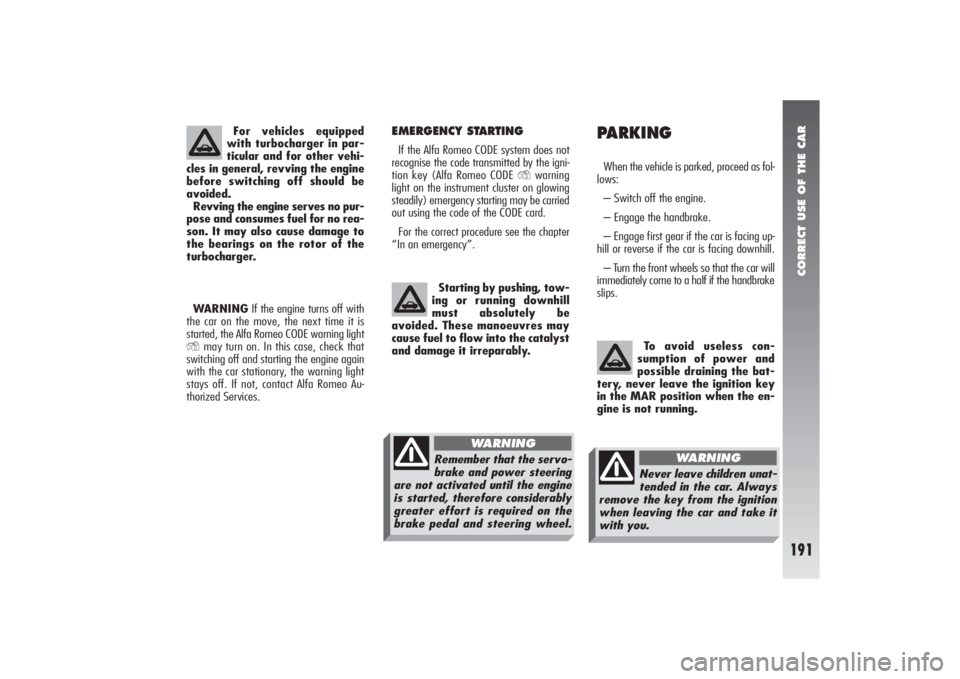
CORRECT USE OF THE CAR
191
EMERGENCY STARTINGIf the Alfa Romeo CODE system does not
recognise the code transmitted by the igni-
tion key (Alfa Romeo CODE
Y
warning
light on the instrument cluster on glowing
steadily) emergency starting may be carried
out using the code of the CODE card.
For the correct procedure see the chapter
“In an emergency”.
PARKINGWhen the vehicle is parked, proceed as fol-
lows:
– Switch off the engine.
– Engage the handbrake.
– Engage first gear if the car is facing up-
hill or reverse if the car is facing downhill.
– Turn the front wheels so that the car will
immediately come to a half if the handbrake
slips. Starting by pushing, tow-
ing or running downhill
must absolutely be
avoided. These manoeuvres may
cause fuel to flow into the catalyst
and damage it irreparably.
To avoid useless con-
sumption of power and
possible draining the bat-
tery, never leave the ignition key
in the MAR position when the en-
gine is not running.
For vehicles equipped
with turbocharger in par-
ticular and for other vehi-
cles in general, revving the engine
before switching off should be
avoided.
Revving the engine serves no pur-
pose and consumes fuel for no rea-
son. It may also cause damage to
the bearings on the rotor of the
turbocharger.
WARNINGIf the engine turns off with
the car on the move, the next time it is
started, the Alfa Romeo CODE warning lightY
may turn on. In this case, check that
switching off and starting the engine again
with the car stationary, the warning light
stays off. If not, contact Alfa Romeo Au-
thorized Services.
Remember that the servo-
brake and power steering
are not activated until the engine
is started, therefore considerably
greater effort is required on the
brake pedal and steering wheel.
WARNING
Never leave children unat-
tended in the car. Always
remove the key from the ignition
when leaving the car and take it
with you.
WARNING
Page 196 of 357
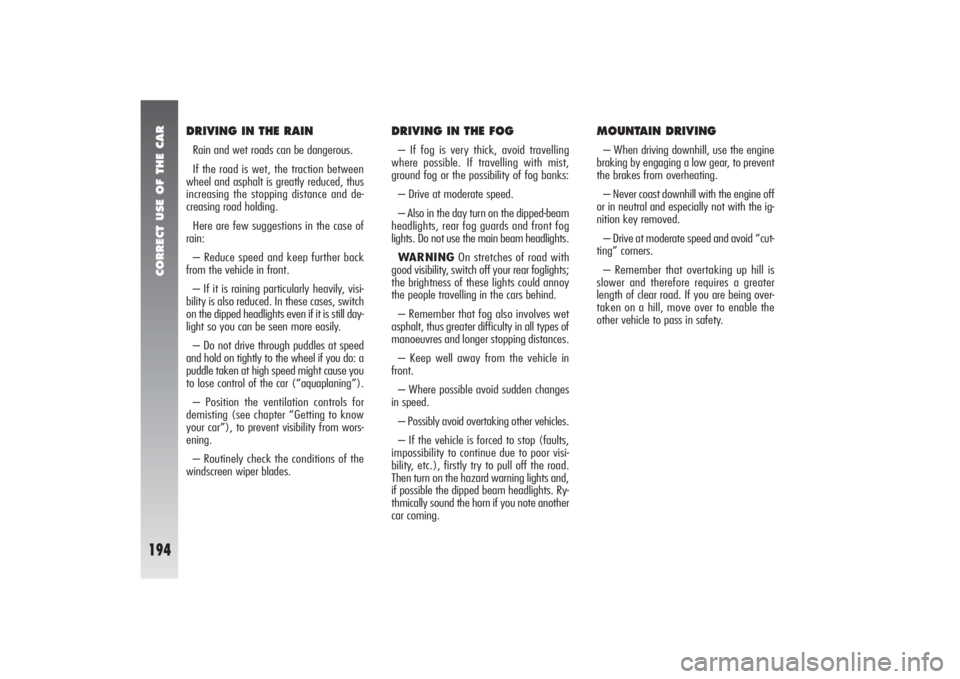
CORRECT USE OF THE CAR
194
DRIVING IN THE RAINRain and wet roads can be dangerous.
If the road is wet, the traction between
wheel and asphalt is greatly reduced, thus
increasing the stopping distance and de-
creasing road holding.
Here are few suggestions in the case of
rain:
– Reduce speed and keep further back
from the vehicle in front.
– If it is raining particularly heavily, visi-
bility is also reduced. In these cases, switch
on the dipped headlights even if it is still day-
light so you can be seen more easily.
– Do not drive through puddles at speed
and hold on tightly to the wheel if you do: a
puddle taken at high speed might cause you
to lose control of the car (“aquaplaning”).
– Position the ventilation controls for
demisting (see chapter “Getting to know
your car”), to prevent visibility from wors-
ening.
– Routinely check the conditions of the
windscreen wiper blades.
DRIVING IN THE FOG– If fog is very thick, avoid travelling
where possible. If travelling with mist,
ground fog or the possibility of fog banks:
– Drive at moderate speed.
– Also in the day turn on the dipped-beam
headlights, rear fog guards and front fog
lights. Do not use the main beam headlights.
WARNINGOn stretches of road with
good visibility, switch off your rear foglights;
the brightness of these lights could annoy
the people travelling in the cars behind.
– Remember that fog also involves wet
asphalt, thus greater difficulty in all types of
manoeuvres and longer stopping distances.
– Keep well away from the vehicle in
front.
– Where possible avoid sudden changes
in speed.
– Possibly avoid overtaking other vehicles.
– If the vehicle is forced to stop (faults,
impossibility to continue due to poor visi-
bility, etc.), firstly try to pull off the road.
Then turn on the hazard warning lights and,
if possible the dipped beam headlights. Ry-
thmically sound the horn if you note another
car coming.
MOUNTAIN DRIVING– When driving downhill, use the engine
braking by engaging a low gear, to prevent
the brakes from overheating.
– Never coast downhill with the engine off
or in neutral and especially not with the ig-
nition key removed.
– Drive at moderate speed and avoid “cut-
ting” corners.
– Remember that overtaking up hill is
slower and therefore requires a greater
length of clear road. If you are being over-
taken on a hill, move over to enable the
other vehicle to pass in safety.
Page 207 of 357

IN AN EMERGENCY
205
3)Fully depress the accelerator pedal and
keep it pressed. The warning light
U
will
come on for eight seconds approximately
and will then go out; now release the ac-
celerator pedal.
4)The warning light
U
begins to flash:
after it has flashed for the same number of
times as the first digit on the code of the
card, press completely and hold down the
accelerator pedal until the warning light
U
comes on (for 4 seconds) and then goes out
again; now release the accelerator pedal.
5)The warning light
U
will begin to
flash: after it has flashed for the same num-
ber of times as the second digit on the code
of the card, press completely and hold down
the accelerator pedal.
6)Repeat this procedure in the same way
for the other digits on the CODE card code.
7)After entering the last figure, keep the
accelerator pedal pressed. The warning light
U
turns on (for four seconds) and then goes
off; now release the accelerator pedal.8)A quick flash of the warning light
U
(for appr. 4 seconds) confirms that the op-
eration has taken place correctly.
9)Start the car turning the ignition key
from theMAR position to the AVV posi-
tion without returning the key to theSTOP
position.
Conversely, if the warning light
U
stays
on, turn the ignition key to STOPand re-
peat the procedure starting from point 1.
WARNINGAfter emergency starting it
is advisable to turn to an Alfa Romeo Au-
thorized Service, because the procedure de-
scribed must be repeated each time the en-
gine is started.
EMERGENCY
STARTINGIf the Alfa Romeo CODE system is not able
to deactivate the engine inhibitor, warning
lights
Y
and
U
remain lit and the engine
cannot be started. To start the engine it is
necessary to follow the emergency starting
procedure.
WARNINGYou are advised to careful-
ly read the entire procedure before carry-
ing it out.
If a mistake is made during the emergency
procedure, the ignition key should be turned
to STOPand the operations must be re-
peated from the start (point 1).
1)Read the 5-figure electronic code on
the CODE card.
2)Turn the ignition key to theMAR po-
sition.
I I
N N
A A
N N
E E
M M
E E
R R
G G
E E
N N
C C
Y Y
Page 223 of 357

IN AN EMERGENCY
221
REPLACEMENT OF XENON
LIGHTS
(optional for versions/
markets where applicable)
Xenon lights have a very long life, there-
fore breakdowns are unlikely.
Hereafter you find the description of the
correct procedure to replace a Xenon light.– Rotate the connector (B-fig. 24) of
the Xenon lamp by a quarter of a turn
counter-clockwise, as indicated in fig. 25,
and remove it.
Dipped-beam headlamps
To replace the bulb proceed as follows:
– Unscrew the three locking screw (B-
fig. 23) and remove the protective (A)
cover.
fig. 23
A0B0348m
fig. 25
A0B0351m
fig. 24
A0B0349m
If necessary, have the sys-
tem checked and repaired
only by Alfa Romeo Authorized
Services.
WARNING
Any operation regarding
the front light units must
be carried out with the lights
turned off and the ignition key re-
moved from the ignition switch:
risk of electric discharges.
WARNING
Page 236 of 357
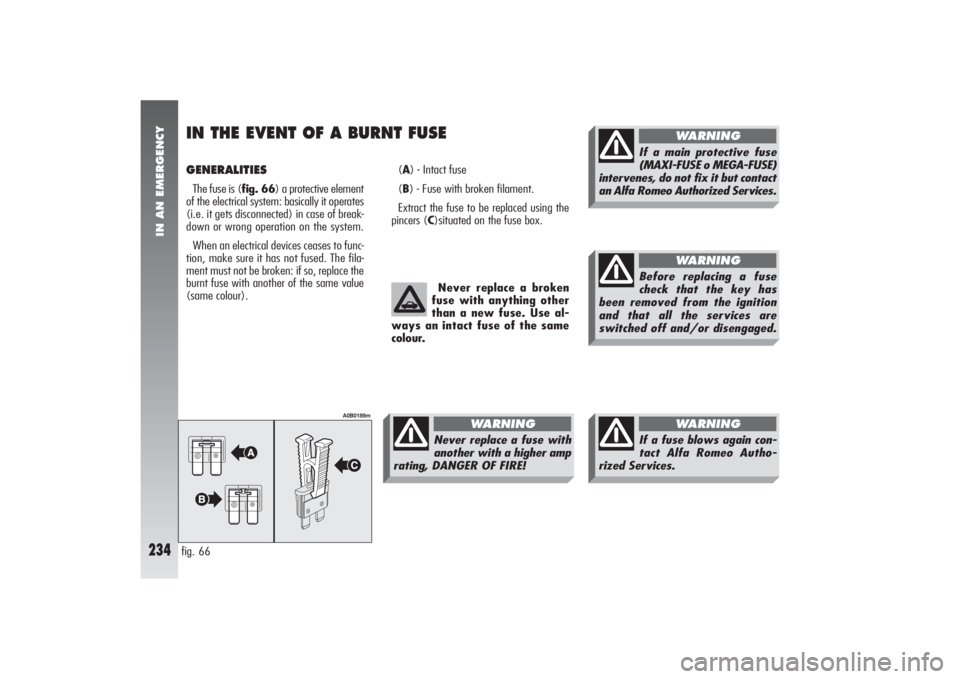
IN AN EMERGENCY
234
GENERALITIES The fuse is (fig. 66) a protective element
of the electrical system: basically it operates
(i.e. it gets disconnected) in case of break-
down or wrong operation on the system.
When an electrical devices ceases to func-
tion, make sure it has not fused. The fila-
ment must not be broken: if so, replace the
burnt fuse with another of the same value
(same colour).(A) - Intact fuse
(B) - Fuse with broken filament.
Extract the fuse to be replaced using the
pincers (C)situated on the fuse box.IN THE EVENT OF A BURNT FUSEfig. 66
A0B0189m
Never replace a broken
fuse with anything other
than a new fuse. Use al-
ways an intact fuse of the same
colour.Never replace a fuse with
another with a higher amp
rating, DANGER OF FIRE!
WARNING
If a main protective fuse
(MAXI-FUSE o MEGA-FUSE)
intervenes, do not fix it but contact
an Alfa Romeo Authorized Services.
WARNING
Before replacing a fuse
check that the key has
been removed from the ignition
and that all the services are
switched off and/or disengaged.
WARNING
If a fuse blows again con-
tact Alfa Romeo Autho-
rized Services.
WARNING
Page 243 of 357
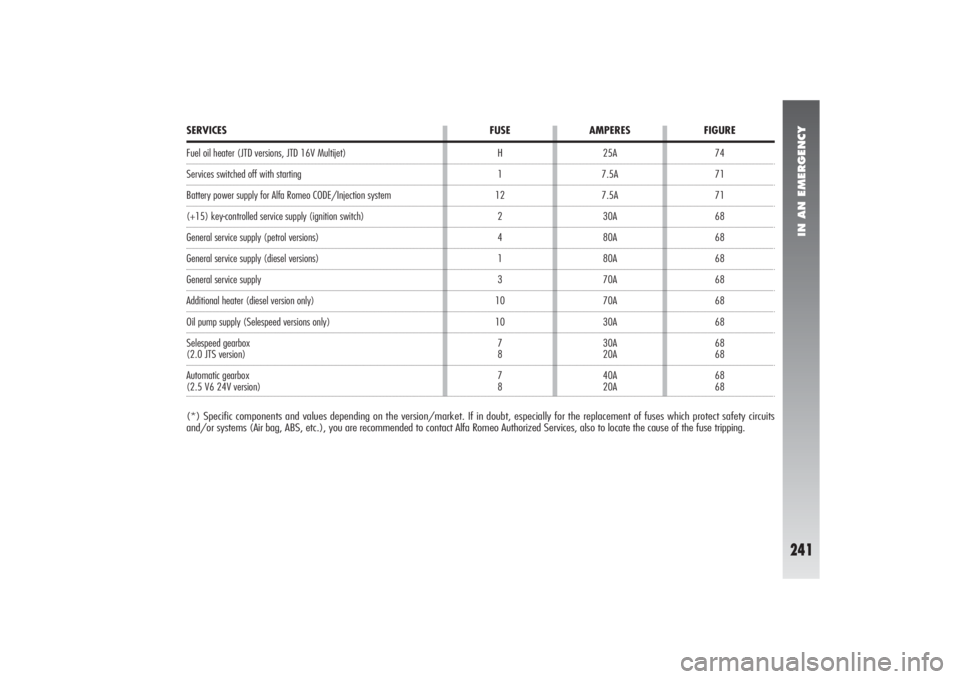
Fuel oil heater (JTD versions, JTD 16V Multijet)Services switched off with startingBattery power supply for Alfa Romeo CODE/Injection system(+15) key-controlled service supply (ignition switch)General service supply (petrol versions)General service supply (diesel versions)General service supplyAdditional heater (diesel version only)Oil pump supply (Selespeed versions only)
Selespeed gearbox(2.0 JTS version)
Automatic gearbox(2.5 V6 24V version)(*) Specific components and values depending on the version/market. If in doubt, especially for the replacement of fuses which protect safety circuits
and/or systems (Air bag, ABS, etc.), you are recommended to contact Alfa Romeo Authorized Services, also to locate the cause of the fuse tripping.
IN AN EMERGENCY
241
74
71
71
68
68
68
68
68
68
68
68
68
68 25A
7.5A
7.5A
30A
80A
80A
70A
70A
30A
30A
20A
40A
20A H
1
12
2
4
1
3
10
10
7
8
7
8
SERVICES FUSE AMPERES FIGURE
Page 245 of 357

IN AN EMERGENCY
243
IF THE VEHICLE IS TO BE TOWEDThe tow ring supplied with the vehicle is
housed in the tool box under the boot mat.
To install the tow ring, proceed as follows:
– Take the tow ring from the tool box.
– Remove the cover (A) snap-fitted on the
front (fig. 77) or rear bumper (fig. 78).
If the supplied flat screwdriver is used to car-
ry out this operation, protect the tip with a
soft cloth to prevent damaging the car.– Firmly screw the ring in its housing.fig. 77
A0B0593m
fig. 78
A0B0594m
Carefully clean the thread-
ed housing before tighten-
ing the ring. Before beginning to
tow the car make sure that the
tow ring is firmly tightened in its
threaded housing.
WARNING
Before beginning to tow
the car, turn the ignition
key to MAR and then to STOP, do
not remove it. Removing the key
automatically engages the steering
lock resulting in the impossibility
to steer the wheels. When towing
remember that without the help of
the servo-brake and power steer-
ing, it is necessary to exert more
effort on the brake pedal and for
steering. Do not use flexible cables
for towing and avoid jerks. Dur-
ing towing operations make sure
that fastening the joint to the car
does not damage the components
in contact with it. When towing the
car it is compulsory to comply with
the specific traffic regulations con-
cerning both the towing device and
behaviour on the road.
WARNING
Page 248 of 357
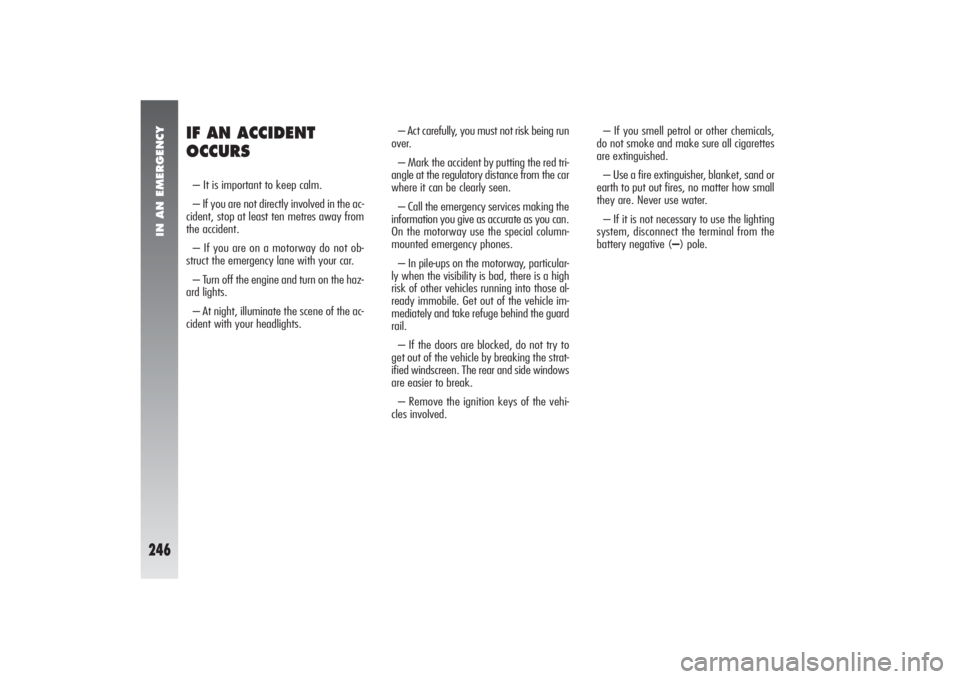
IN AN EMERGENCY
246
IF AN ACCIDENT
OCCURS– It is important to keep calm.
– If you are not directly involved in the ac-
cident, stop at least ten metres away from
the accident.
– If you are on a motorway do not ob-
struct the emergency lane with your car.
– Turn off the engine and turn on the haz-
ard lights.
– At night, illuminate the scene of the ac-
cident with your headlights.– Act carefully, you must not risk being run
over.
– Mark the accident by putting the red tri-
angle at the regulatory distance from the car
where it can be clearly seen.
– Call the emergency services making the
information you give as accurate as you can.
On the motorway use the special column-
mounted emergency phones.
– In pile-ups on the motorway, particular-
ly when the visibility is bad, there is a high
risk of other vehicles running into those al-
ready immobile. Get out of the vehicle im-
mediately and take refuge behind the guard
rail.
– If the doors are blocked, do not try to
get out of the vehicle by breaking the strat-
ified windscreen. The rear and side windows
are easier to break.
– Remove the ignition keys of the vehi-
cles involved.– If you smell petrol or other chemicals,
do not smoke and make sure all cigarettes
are extinguished.
– Use a fire extinguisher, blanket, sand or
earth to put out fires, no matter how small
they are. Never use water.
– If it is not necessary to use the lighting
system, disconnect the terminal from the
battery negative (–) pole.
Page 250 of 357

CAR MAINTENANCE
248
It is however wise to remember that Pro-
grammed Maintenance does not complete-
ly cover all the car’s requirements: also in
the initial period before 20,000 km service
coupon and later, between one coupon and
another, ordinary care is still necessary such
as for example routinely checking and top-
ping up the level of fluids, checking the tyre
pressure, etc...
WARNINGThe Programmed Mainte-
nance coupons are specified by the Manu-
facturer. The failure to have them carried out
may invalidate the warranty.
The Programmed Maintenance service is
carried out by all Alfa Romeo Authorized Ser-
vices, at pre-established times.If during each operation, in addition to the
ones programmed, the need arises for fur-
ther replacements or repairs, these may be
carried out only with the explicit agreement
of the customer.
WARNINGYou are advised to contact
Alfa Romeo Authorized Services in the event
of any minor operating faults, without wait-
ing for the next service coupon.
PROGRAMMED
MAINTENANCECorrect maintenance is essential for en-
suring long car life under the best conditions.
This is why Alfa Romeo has programmed
a series of checks and maintenance opera-
tions every 20,000 km.
WARNINGAt 2000 km from the main-
tenance deadline, the Infocenter display will
show “SCHEDULED SERVICE WITHIN” which
is shown again turning the ignition key to
MAR, every 200 km. For further details,
see “Service” in the “Display Infocenter”
paragraph in “Getting to know your car”
chapter.
C C
A A
R R
M M
A A
I I
N N
T T
E E
N N
A A
N N
C C
E E
Page 255 of 357

CAR MAINTENANCE
253
Car maintenance should be
entrusted to Alfa Romeo
Authorized Services. For
routine and minor maintenance op-
erations you wish to carry out
yourself, always make sure you
have the proper equipment, genuine
Alfa Romeo spare parts and the
necessary fluids; do not however
carry out these operations if you
have no experience.
WARNING
Pollen filter
If the car is used frequently in dusty or
heavily polluted environments it is advisable
to replace the filtering element more fre-
quently; in particular it should be replaced if
a reduction of the amount of air admitted to
the passenger compartment is noted. WARNING
Battery
You are recommended to have the battery
charge conditions checked, preferably at the
onset of winter, to avoid the possibility of
freezing the electrolyte.
This check should be carried out more fre-
quently if the car is used prevailingly for
short journeys, or if it is fitted with services
that absorb high amounts of current per-
manently with the ignition key off, especially
if installed in the after market.
In the case of use of the car in hot climates
or particularly harsh conditions, it is wise
to check the level of the battery fluid (elec-
trolyte) at more frequent intervals than stat-
ed in the Scheduled Maintenance Pro-
gramme.